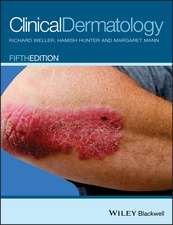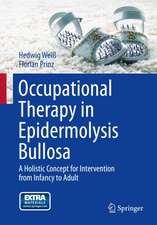Patch Testing
Autor S. Fregert, H. -J. Bandmannen Limba Engleză Paperback – noi 1975
Preț: 355.95 lei
Preț vechi: 374.68 lei
-5% Nou
Puncte Express: 534
Preț estimativ în valută:
68.11€ • 74.28$ • 57.43£
68.11€ • 74.28$ • 57.43£
Carte tipărită la comandă
Livrare economică 24 aprilie-08 mai
Preluare comenzi: 021 569.72.76
Specificații
ISBN-13: 9783540072294
ISBN-10: 3540072292
Pagini: 88
Ilustrații: VIII, 80 p. 3 illus.
Dimensiuni: 133 x 203 x 5 mm
Greutate: 0.1 kg
Ediția:1975
Editura: Springer Berlin, Heidelberg
Colecția Springer
Locul publicării:Berlin, Heidelberg, Germany
ISBN-10: 3540072292
Pagini: 88
Ilustrații: VIII, 80 p. 3 illus.
Dimensiuni: 133 x 203 x 5 mm
Greutate: 0.1 kg
Ediția:1975
Editura: Springer Berlin, Heidelberg
Colecția Springer
Locul publicării:Berlin, Heidelberg, Germany
Public țintă
ResearchCuprins
1. General Aspects.- 1.1 Introduction.- 1.2 Historic Development.- 1.3 Principles of Patch Testing.- 1.4 Indications.- 1.5 Contraindications.- 2. Test Technique.- 2.1 Principles of the Technique.- 2.2 Test Substances.- 2.3 Vehicles.- 2.4 Storage.- 2.5 Concentrations.- 2.6 Selection of Test Substances.- 2.7 Test Material.- 2.8 Application of the Test Substance to Patch.- 2.9 Adhesive Tape.- 2.10 Application on the Skin.- 2.11 Skin Marking.- 2.12 Exposure Time.- 2.13 Time of Reading.- 2.14 Advice to the Patient.- 3. Types of Reactions.- 3.1 Allergic Reactions.- 3.2 Late Reactions.- 3.3 Irritant Reactions.- 3.4 Irritant Reactions in Children, the Aged, and Atopic Subjects.- 3.5 Differentiation between Allergic and Irritant Reactions.- 3.6 Treatment of Test Reactions.- 3.7 Recording the Reactions.- 3.8 False-Negative Reactions.- 3.9 False-Positive Reactions.- 4. Other Test Methods.- 4.1 Open Test.- 4.2 Intracutaneous Test.- 4.3 Testing on Mucous Membranes.- 5. Photo Patch Testing.- 5.1 Principle.- 5.2 Source of Light.- 5.3 Technique.- 5.4 Indications.- 6. Patch Test Results Used in Clinical Management.- 6.1 Interpretation of Reactions.- 6.2 Inexplicable Reactions.- 6.3 Definite Diagnosis.- 6.4 Treatment.- 6.5 Allergy Card.- 6.6 Prognosis.- 6.7 Rehabilitation.- 6.8 Prevention.- 6.9 Legal Aspects.- 6.10 Disadvantages of Patch Testing.- 7. General Aspects of Sensitizers.- 7.1 A Characterization of Eczematogenic Substances as Test Reagents.- 7.2 Mixtures of Test Substances.- 7.3 Cross-Allergy.- 7.4 Concomitant Allergy.- 7.5 Standard Tests.- 8. Special Aspects on Sensitizers.- 8.1 Chino form and Chlorquinaldol.- 8.2 Chlorpromazine Promethazine.- 8.3 Epoxy Resin.- 8.4 Benzocaine.- 8.5 Formaldehyde.- 8.6 Rubber Chemicals.- 8.7 Chromium.- 8.8 Cobalt.- 8.9 Nickel.- 8.10 Lanolin Alcohols.- 8.11 Mafenide Sulfatolamide, Sulfamylon.- 8.12 Neomycin.- 8.13 Colophony (Rosin).- 8.14 Parabens.- 8.15 Para-Dyes.- 8.16 Balsam of Peru.- 8.17 Mercury, Mercury Salts, and Phenyl-Mercury Compounds.- 8.18 Turpentine.- 9. Test Substances.- 10. Flow Chart for Patch Testing.- 11. Bibliography.- 12. Index.- 12.1 General.- 12.2 Chemicals.












